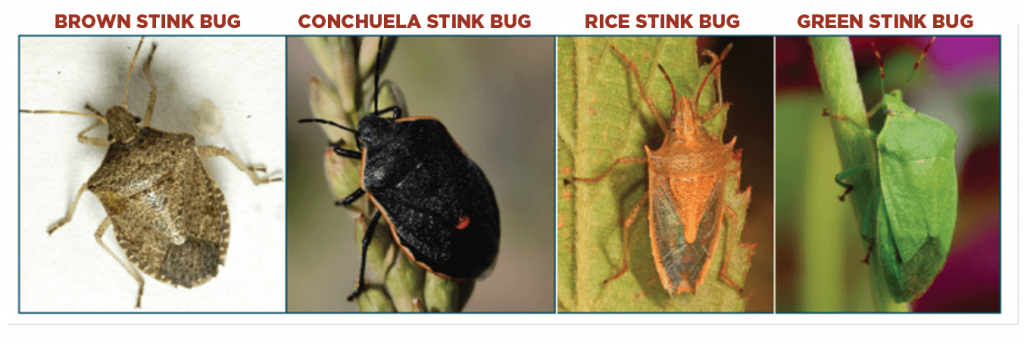
Stink Bugs
Stink bugs are mostly an issue in the southern states where they feed directly on grain kernels. They have piercing sucking mouthparts and reduce yield by reducing the size of the kernels and reducing test weight. Stinkbugs cause more kernel damage during the early grain development from milk through soft dough stage. Infestation during flowering can reduce the number of seed per panicle, while later infestations generally reduce kernel weight but not number of seed.
To scout for stink bugs use the beat-bucket method described below:
- Shake grain sorghum heads into a bucket and count bugs.
- Randomly sample at least 30 heads from various regions of the field.
- Calculate the average number of stink buts per sorghum head.
Treatment thresholds will vary depending on the species of stink bug and are discussed below.
The four most common stink bugs found in sorghum are listed below:

Of these, rice stink bug (Oebalus pugnax) causes the most damage and is straw colored, shield shaped and 1/2 inch long and is mostly an issue in South Texas. Texas A&M AgriLife Extension bases its economic threshold on the number of rice stink bugs per acre, value of the grain and cost of control. For example, if the grain value is $8.00 per 100 lbs of grain and the cost of treatment is $10 per acre then the economist threshold is 38,000 rice stink bug per acre. After scouting if the average number of rice stink bugs per head is 1.5 and there are 50,000 head per acre, the infestation level is 75,000 per acre, well above the economic threshold. In this example the rice stink bug threshold is 0.76 bugs per head (38,000/50,000). As a general rule of thumb 0.5 to 1.0 rice stink bug per head will be the economic threshold depending on the plant population.

The southern green stink bug (Nezara viridula) and the conchuela stink bug (Chlorochroa ligata) may also lower the yield of sorghum. The southern green stink bug is bright green, shield shaped and slightly longer than 1/2 inch. The conchuela stink bug may vary in color from dull olive or ash gray, to green, purplish pink or reddish brown. Look for orange-red bands on the outside margins of the thorax and wings and a spot of the same color on its back. The treatment threshold for these two stink bugs are four or more bugs per grain head during the flowering, milk, and soft dough stages. Once the hard dough stage has been reached, the threshold increases to 16 per grain head.
Another bug that can occasionally reach threshold levels in grain sorghum is the leaffooted bug (Leptoglossus phyllopus).

The threshold level for the leaffooted bug is an average of six or more bugs during flowering, milk, and soft dough stages of grain sorghum and increases to 16 bugs once the hard dough stage has been reached.
It should be noted that Oklahoma State Extension uses a threshold for all stink bugs of 5 bugs per head at the milk stage and 9 bugs per head at the soft dough sage.
For insecticide recommendations see the various state insecticide guides or discuss options with regional extension entomologists.

